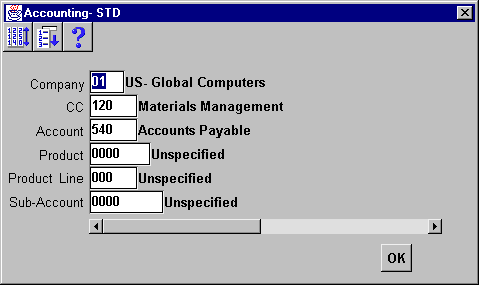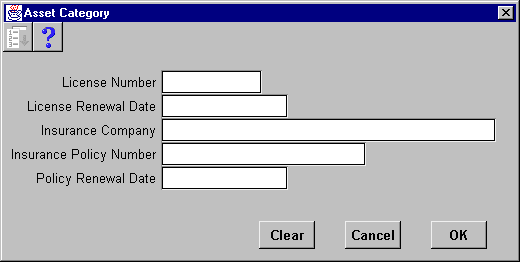Overview of Flexfields
A flexfield is a flexible data field that your organization can customize to your business needs without programming. Oracle Applications uses two types of flexfields, key flexfields and descriptive flexfields. A key flexfield is a field you can customize to enter multi-segment values such as part numbers, account numbers, and so on. A descriptive flexfield is a field you customize to enter additional information for which your Oracle Applications product has not already provided a field.
Basic Business Needs
Oracle Applications flexfields let you satisfy the following business needs:
- Have "intelligent fields"--fields comprised of one or more segments, where each segment has both a value and a meaning.
- Rely upon your application to validate the values or the combination of values that you enter in intelligent fields.
- Have the structure of an intelligent field change depending on data in your application.
- Capture additional information if you so choose.
- Customize data fields to your meet your business needs without programming.
- Query intelligent fields for very specific information.
Definitions
Key Flexfields
A key flexfield is a field made up of segments, where each segment has both a value and a meaning. You can think of a key flexfield as an "intelligent" field that your business can use to store information represented as "codes."
Most organizations use "codes" to identify general ledger accounts, part numbers, and other business entities. Each segment in the code represents a characteristic of the entity. For example, your organization may use the part number code "PAD-NR-YEL-8 1/2x14" to represent a notepad that is narrow-ruled, yellow, and 8 1/2" by 14". But another organization may identify the same notepad with the part number code "PD-8x14-Y-NR". Although both codes represent the same part, they each have a different segment structure that is meaningful only to the organization using that code.
A key flexfield is flexible enough to let you use any code scheme you want to describe an entity. When your organization initially installs an Oracle Applications product, your organization's implementation team customizes all the key flexfields in that product to use meaningful code segments to describe each key flexfield entity. Your organization decides for each key flexfield, how many segments an entity has, what each segment means, what values each segment can have, and what each segment value means. Your organization can also define rules that govern what combination of segment values are valid (cross-validation rules), or define dependencies among the segments. The result is that your organization can use the codes it needs rather than change its codes to meet someone else's requirements.
The Accounting Flexfield in your Oracle Assets application is an example of a key flexfield that identifies a unique chart of accounts. One organization may choose to customize the Accounting Flexfield to have three segments called Company, Department, and Account, while another organization may choose to customize the flexfield to have six segments called Company, Cost Center, Account, Product, Product Line, and Subaccount, as shown in Figure 1 - 48 in the Account column.
Figure 1 - 48.

A key flexfield looks like any other field in a block. You can simply type into a key flexfield, the segment values you want and separate each segment with a character called a segment separator. In Figure 1 - 48, the designated segment separator for the Accounting Flexfield is a period ".". Alternatively, as shown in Figure 1 - 49, you can open a flexfield window for a key flexfield to display a separate field for each of its segments.
Figure 1 - 49.

Combination of Segment Values
A combination of segment values, also known as a key flexfield code combination, uniquely describes a business entity stored in a key flexfield. When you change the value of one or more segments in a key flexfield, you change the combination of segment values.
Descriptive Flexfields
A descriptive flexfield gives you room to expand your forms, since Oracle Applications cannot predict all the possible information you may want to track. Your organization can use descriptive flexfields to capture additional information that is important and unique to your business.
A descriptive flexfield appears in a block as a two character, unnamed field enclosed in brackets, as shown in Figure 1 - 50. A descriptive flexfield window appears when you move your cursor into a customized descriptive flexfield, as shown in Figure 1 - 51. Your organization's implementation team can customize a descriptive flexfield to include as many additional fields as your organization needs. These fields, also called segments, appear in the descriptive flexfield window.
Note: We refer to the fields that appear in a customized descriptive flexfield as segments even though they differ from the segments that make up a single value in a key flexfield.
Each segment in a descriptive flexfield window has a name, and can have a set of valid values. Your organization can define dependencies among the segments or customize a descriptive flexfield to display context-sensitive segments, so that different segments appear depending on the values you enter in other fields or segments.
In Figure 1 - 50, your organization might customize the descriptive flexfield to display fields that store more information about the asset category.
Figure 1 - 50.

Figure 1 - 51.

Range Flexfield
A range flexfield is a variation of a key flexfield that allows you to input a low and a high combination of segment values so that you can express a range of key flexfield combinations.
Structure
A structure is a specific configuration of flexfield segments. If your organization's implementation team adds or removes segments, or rearranges the order of segments in a flexfield, you get a different structure.
Major Features
Flexfield Window
Both key and descriptive flexfields display flexfield windows. A flexfield window displays the segments of a flexfield as individual fields with field prompts.
Choose List of Values... or Edit Field... from the Edit menu to display key flexfield windows.
Note: Single segment key flexfields and range flexfields display all of their segments in fields on the form and are therefore not displayed in a flexfield window.
For a descriptive flexfield, you can define whether you want the flexfield window to automatically appear when you navigate to a customized descriptive flexfield. If you set a user profile option called Flexfields: Open Descr Window to No, the window does not open unless you choose Edit Field... from the Edit menu. If you set the user profile option to Yes, a flexfield window automatically opens when you navigate into a customized descriptive flexfield except in a folder.
The menus on the main menu bar change when you open a flexfield window. We refer to the updated menu bar as the flexfield window menu bar, which contains the following menus:
- Edit--Use the Edit menu to edit the data in the flexfield window. You can clear the data from a segment field, display a list of values for a segment field (if it contains a list), invoke the field editor for a segment, or clear all data from the block.
- Go--Use the Go menu to navigate to the next or previous segment field.
- Special--Use the Special menu to display the default value for a segment field (if it has a default) or to display default values for all the segments in the flexfield window that have defaults.
- Window--The Window menu lets you select different ways to arrange your currently open windows.
Automatic Segment Validation
Some flexfields can validate the segment values that you enter against a list of valid values. If you enter an invalid segment value, a list window appears so that you can choose a valid value from the list.
Automatic Segment Cross-Validation
A key flexfield can perform automatic cross-validation of segment values according to rules your organization defines when it customizes that key flexfield. A cross-validation rule defines whether a value of a particular segment can be combined with specific values of other segments. When you finish entering segment values in your key flexfield window, your application checks to see if it is a valid combination of values before it updates the database. If you enter an invalid combination, a modal window appears with a message telling you to choose a combination that is already defined.
Dynamic Insertion
Dynamic insertion allows you to create a combination of segment values for a key flexfield without using a combinations form. During the implementation of a key flexfield, your organization can either explicitly define a list of valid code combinations for the key flexfield using a combinations form, or allow you to create valid combinations as you enter values in the key flexfield for the first time on a form other than the combinations form. Your organization can also specify cross-validation rules for a key flexfield so that you can only define specific code combinations during dynamic insertion.
Multiple Flexfield Structures
In some applications, different users may need a different arrangement of flexfield (key or descriptive) segments. Or, you might want different segments to appear in a flexfield depending upon, for example, the value of another field.
Depending on the flexfield, your organization can define multiple segment structures for the same flexfield. The flexfield can display different prompts and fields for different users based on a data condition in a form or application database.
Your Oracle General Ledger application, for example, can provide different Accounting Flexfield structures for users of different sets of books. The Oracle General Ledger application determines which flexfield structure to use based on the value of a profile option called GL Set of Books Name.
Shorthand Flexfield Entry
Shorthand flexfield entry lets you enter key flexfield data quickly using alias names that represent valid flexfield combinations or patterns of valid segment values. Your organization can specify which key flexfields use shorthand flexfield entry, and define shorthand aliases for those key flexfields to represent complete or partial sets of key flexfield segment values. Once your organization customizes a key flexfield to use shorthand flexfield entry, you can set the user profile option Flexfields:Shorthand Entry to take advantage of this feature.
Flexfield Value Security
Flexfield value security allows your organization to restrict the set of key flexfield segment values you have access to during data entry. The security is based on a your responsibility and the access rules your organization defines.
See Also
Entering Data in a Range Flexfield
Setting Your Personal User Profile
Cross-Validation Rules
Overview of Shorthand Flexfield Entry
Defining Shorthand Aliases
Overview of Flexfield Value Security



